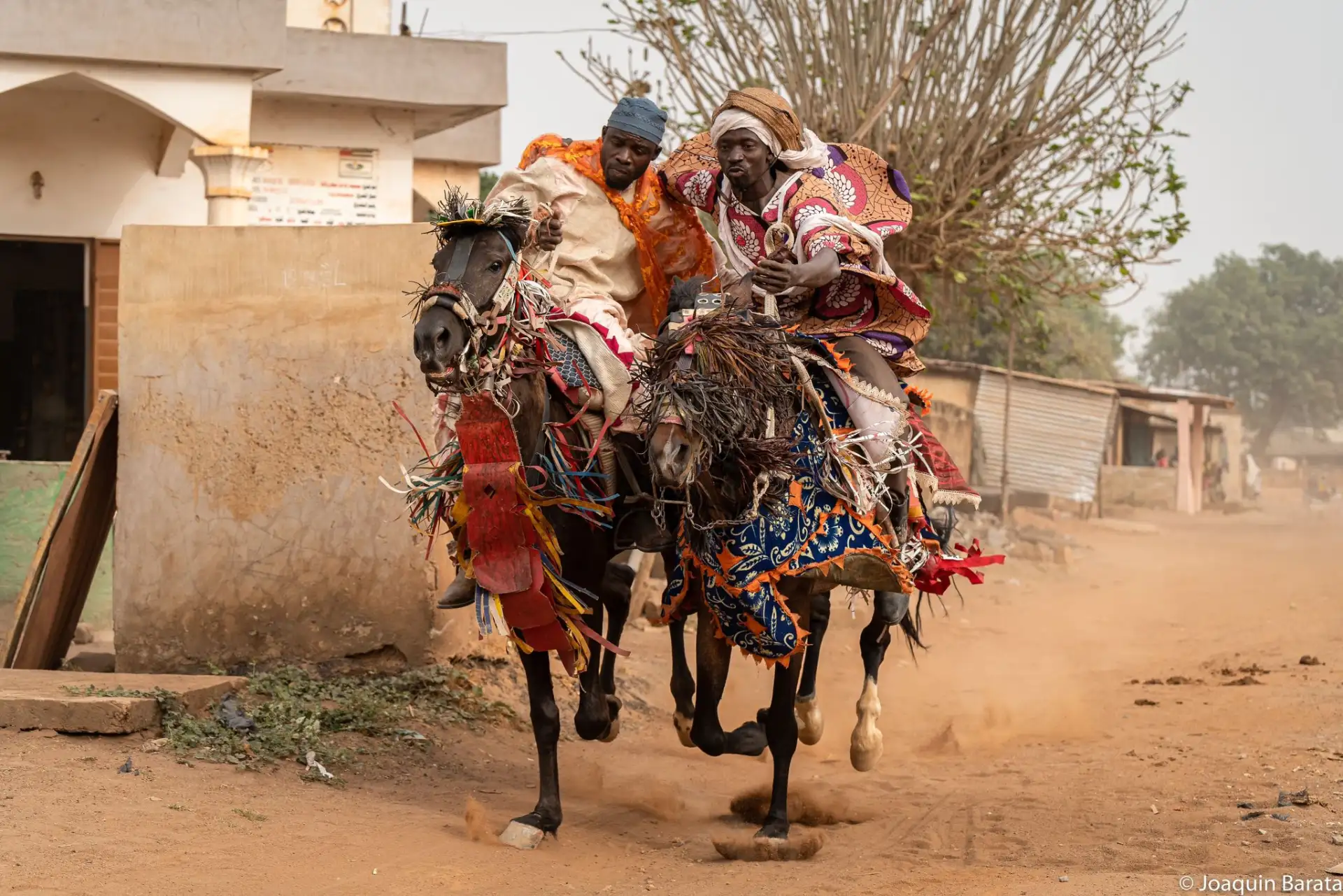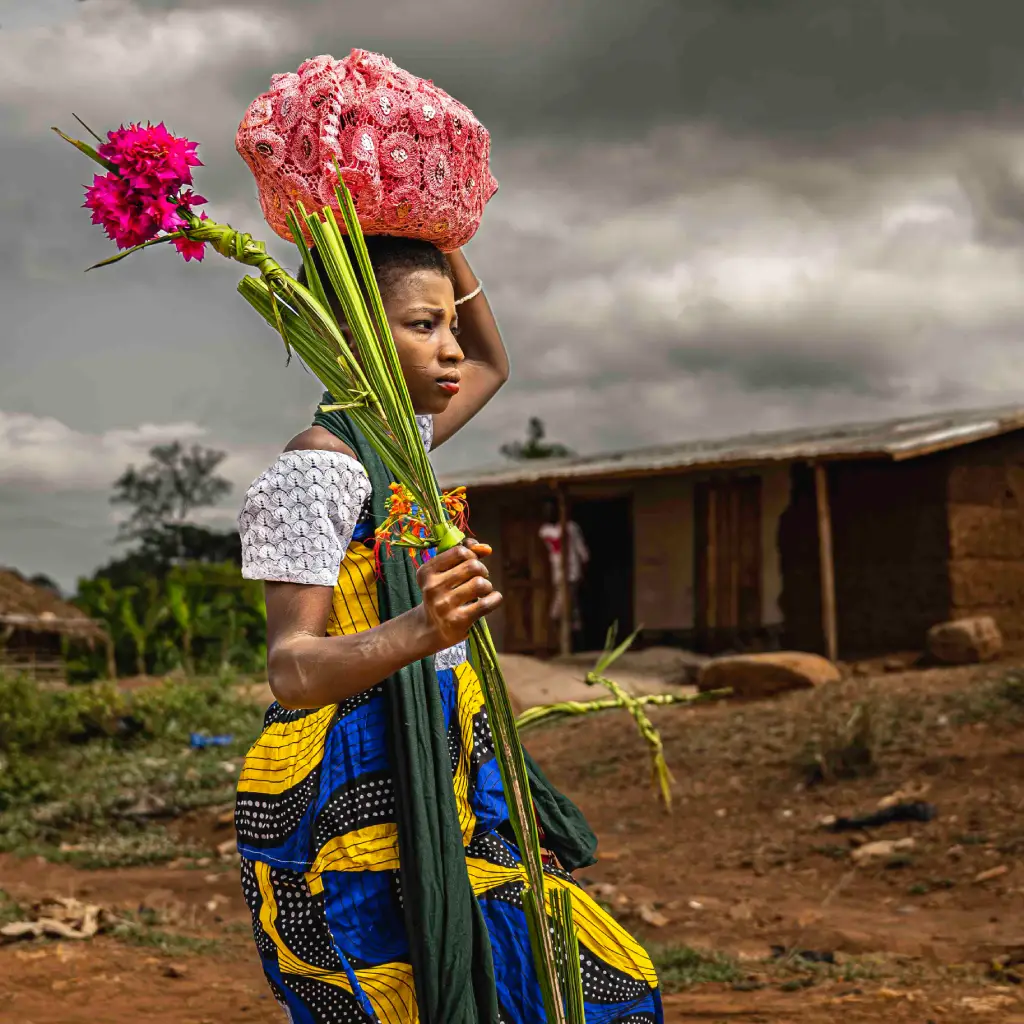Day 1: International Flight and Arrival
International flight and arrival in Cotonou. We will be picked up at the airport and transferred to the hotel to rest.
Day 2: Cotonou and Ganvie
Cotonou, a port city marked by remnants of the communist era, is the economic capital of Benin. To grasp the essence of the city, we will visit the Dantokpa Market, one of the largest in the Gulf of Guinea — our first introduction to the colours, smells, and flavours of West Africa. Here, we will witness one of its most distinctive features: colourful clothing and hairstyles, as well as an introduction to the world of voodoo through the market fetishes.
Afterwards, we will head to Calavi, a lakeside port from where we’ll take a pirogue to explore Lake Nokoué and reach Ganvie, one of the country’s highlights. This stilt village, inhabited by the Tofin people, allows us to observe how everyday life unfolds entirely by canoe.
In the afternoon, we will return to Cotonou.
Day 3: Porto-Novo and the Holi Ethnic Group
This day will be a blend of colonial and indigenous culture, enjoying a wide variety of architectural styles, fascinating cities and towns with a strong identity. We will start with a visit to Porto Novo, the administrative capital of Benin, famous for its rich architecture: churches, mosques, voodoo temples, French colonial buildings and outstanding Afro-Brazilian architecture, which blends the best of European and local influences. The fascinating mosque is the most representative example of this.
Then, we will head north to see the Holi, an animist people who stand out because the women of a certain age wear complex body tattoos. It is worth observing their beautiful bamboo architecture, as well as the facial scarifications of the people, a symbol of tribal membership and also an aesthetic component.
We will learn how they are made and what they mean, and we will see how a people anchored in the past lives, which, from an anthropological and photographic point of view, is of great interest.
Day 4: Fulani Ethnic Group
On our journey westward, we will again attempt to be received by the king of Cove, a key figure in the region. We will then continue our trip to discover one of the most fascinating ethnic groups — the Fulani — a nomadic, Islamised people known for their elegance.
Tall and slender, the Fulani are known for their beauty and striking facial decorations. Through their traditions, we will learn about a nomadic way of life reflected in the architecture of their homes.
At night, we will arrive in Abomey, where we will stay overnight.
Day 5: Abomey and Dassa
In Abomey, the former capital of Benin, we will visit the Royal Palace — a UNESCO World Heritage Site — where valuable historical objects are preserved. Here, we will learn about the fascinating Kingdom of Dahomey, which eventually succumbed to the French.
Then, we will continue our journey northward, spending the night in Dassa before climbing the sacred mountain, dotted with voodoo temples, where we will watch a beautiful sunset.
Day 6: Taneka Ethnic Group
We will begin the day heading north towards the territory of the Taneka tribe. Upon arrival, we will gather in the village’s spiritual centre and visit the royal palace, where we can witness their entirely ancestral way of life.
The village priests, dressed in loincloths and smoking pipes, will offer us a unique insight into their lifestyle. Throughout the visit, we will observe how traditions and spirituality remain deeply connected to the past, preserving an authentic and singular way of life.
Day 7: Somba Ethnic Group
We will make our final visits in the area before continuing our journey to the Atakora Mountains, the highest point in Benin, where the landscape transforms into mountains and small valleys inhabited by various animist ethnic groups, particularly the Somba — known as adobe craftsmen.
Their famous two-storey houses, called tata, are a unique example of African architecture and deserve a leisurely visit. Getting to know this group offers immense anthropological value, and together with the Taneka, they are one of the most representative ethnic groups in northern Benin, with traditions and architecture that preserve fascinating authenticity.
Day 8: Kara
We cross the border into Togo to explore the region of Koutammakou, home to the Batammariba. This area is renowned for its buildings, which are listed as a UNESCO World Heritage Site. Most houses are two-storey structures, and the granaries feature cylindrical bases topped with a hemispherical structure, much like the Somba’s tata.
Days 9 and 10: Sokodé and Kpalimé
We will begin the long journey south, stopping in Sokodé to enjoy nature and meet ethnic groups such as the Kotokoli and Lossi. We will take a nature hike up Mount Agou (800 metres), the highest point in Togo.
We will then continue to Kpalimé, where we will spend the night.
Day 11: Lomé
After breakfast, we will make our way to Togo’s capital, Lomé, where we will visit the Grand Marché and the cathedral — its Protestant German-influenced architecture and location in the heart of the bustling market make for a striking contrast.
We will also visit the fetish market and the Independence Monument, among other points of interest.
Day 12: Lake Ahemé
We will cross the border again and head to Lake Ahemé, one of Togo’s most fascinating destinations. Here, we will discover voodoo in its most authentic form.
This animist religion — which has nothing to do with dolls stuck with pins or zombies — is a deeply rooted and respected belief system that sees all of nature as imbued with spirit. On this trip, we will experience its true essence by participating in rituals and ceremonies.
We will also visit the Temple of Skulls, dedicated to Shango, the Yoruba god of justice and weather.
Day 13: Grand Popo
After several days on the road, we will take a day to relax on the beaches of Grand Popo. We will enjoy a pirogue excursion through the Mono River delta, where we can observe birds and mangroves in a stunning natural setting.
Day 14: Ouidah
As we near the end of the trip, we will visit Ouidah — a city that brings to life the history of the slave trade in the region.
We will follow the “Slave Route”, from the auction square to the “Point of No Return” — a symbolic place. From here, more than two million slaves departed for the Caribbean, Brazil and the United States.
During the tour, we will visit various stages the slaves passed through before boarding, including sites like the “Black Box” and mass graves — spaces that invite deep reflection on the history of those who were taken from this land.
At the end of the day, we will head to Cotonou, where we will spend the night.
Day 15: Cotonou
This final day serves as a ‘wild card’ in case we decided to extend our stay at any place that fascinated us earlier in the trip.
If we are in Cotonou, we will be able to visit African art exhibitions, stroll through the city, and do some last-minute shopping before our return flight.



